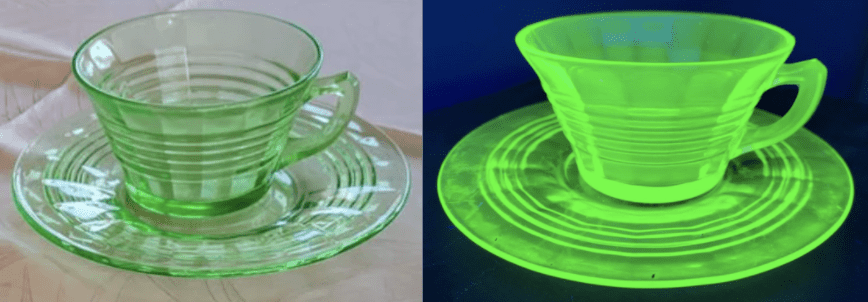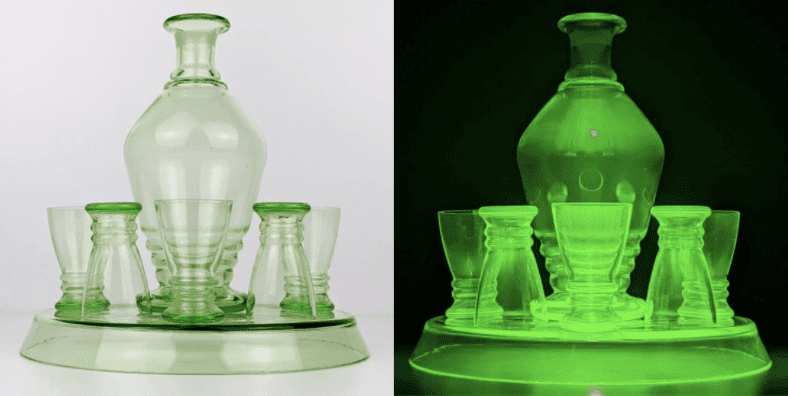The beautiful glowing green plates and cups may have caught your attention and now you ask yourself, what is uranium glass and how did it start being made. Well, uranium glass, sometimes called Vaseline glass, has a long and complex history that continues up until even now.
Uranium glass was originally made by a glassworker named Josef Reindel in 1830. He first started making this glass in 1830 at his factories located in the now Czech Republic region called Bohemia. Uranium glass continued to be made right up until World War II.
However, even after governments began to limit the use of radioactive materials, uranium glass continued to be made. And still to this day several large glassmaking companies continue to produce the glass, but how much is this glass worth, and is the uranium in the glass dangerous?

Early History of Uranium Glass
While it is unsure who invented uranium glass, Josef Reindel is most often given credit for it. However, in 1789 some believe a German, Martin Klaproth, was the first person to use uranium as a coloring agent in his glass.
But whether it was first made in 1789 or 1830, the uniquely colored yellow-green and yellow glass quickly began to be produced and was highly valued during a time when glassmaking was highly competitive. After Reindel began producing his glass, many companies began to try and figure out how he created the colored glass and 8 years later, several French companies finally began producing uranium glass of their own.
Over the next several years they began to find ways to make other colors including the popular opaque apple-green as well as a deep red color when lead was added. It was these French glassmakers testing that made the most common style of uranium glass, Vaseline glass. This glass had a yellow color that received its name from the ointment that shared a similar color.

The popularity of Uranium glass continued to grow and grow, reaching its peak popularity between the 1880s and the 1920s. Uranium glass likely would have continued to be produced at a high rate and also grown in popularity, but actions taken by many world governments prevented this.
Due to World War II, governments took all supplies of uranium for several different reasons. The biggest reason within the United States was because a large portion of uranium was being used in the Manhattan Project in their attempts to create the first nuclear weapon. Another major reason was that there were beginning to be concerns about how the radioactive materials were affecting the health of the glassworkers.
So from around 1943, there was a ban on radioactive materials and glassworkers were unable to create more uranium glass until the ban was lifted in 1958. And while it is now possible for glassworkers to get the material again, they have since found other, cheaper materials to create similar colors so many companies did not create uranium glass again.
Modern History of Uranium Glass
Since the ban was lifted a few companies have begun to produce more uranium glass, however, the number of companies that produce it is very small due to the high cost of uranium oxide, the material used to create the green color and glow in the glass. Some of the few companies that continued to create uranium glass were Fenton Glass, Mosser Glass, Gibson Glass, and Jack Loranger.
Throughout the late 1900s, glassmakers who made uranium glass continued to improve and find new techniques to create different styles and colors of uranium glass. One of these methods was to use more iron oxide, which helped create a more green color within the glass, and this again helped many companies increase their sales. Another style of uranium glass that helped major companies like Fenton was Burmese glass. This glass appears as a pink that transitions into a yellow at the bottom, however when ultraviolet light is shined on it, it still produces the bright green color.

Fenton Glass continued to produce a large variety of unique glass for many years after the uranium ban. Their main methods were through a variety of contracts with companies and also through the creation of many collector series of glass. From carnival glass plates to Burmese glass cats, the large collector series helped keep Fenton in business until 2007, when they announced that they were ceasing operation. And while Fenton has continued to produce glass due to the influx of orders after this announcement, the future of glass from them is still unsure.
Current Value of Uranium Glass
Due to the massive variety of objects that are made of uranium glass, it is difficult to give a set price for uranium glass objects. However, the majority of pieces that you can find on online shops tend to be around the $10-$50 price range. When it comes to larger objects such as vases, large bowls, complete sets, and older pieces, the price can quickly rise to 100 dollars and in some instances get to nearly 500 dollars.
Is Uranium Glass Dangerous
Uranium glass is radioactive, whenever you point a Geiger-counter towards a piece, you will get a positive reading, and when you point an ultraviolet light at it, the piece will shine a bright green color. Because of concerns for both worker and purchaser safety, there have been many tests done by different companies on how safe it is to have a radioactive piece of glass in your home.

In these tests, they found that for every 2 pounds of uranium oxide that were added into the mixture, another 184 pounds of other materials were also added, meaning that only 1% of the glass is made up of uranium. And even though the exact quantity of uranium in each piece of glass varies, even the pieces with the largest amount of uranium in them, (20%) are not harmful. These pieces have the uranium oxide locked behind the melted glass and so even when you use them as plates and cups, the radiation is no more harmful than a microwave oven or television.

